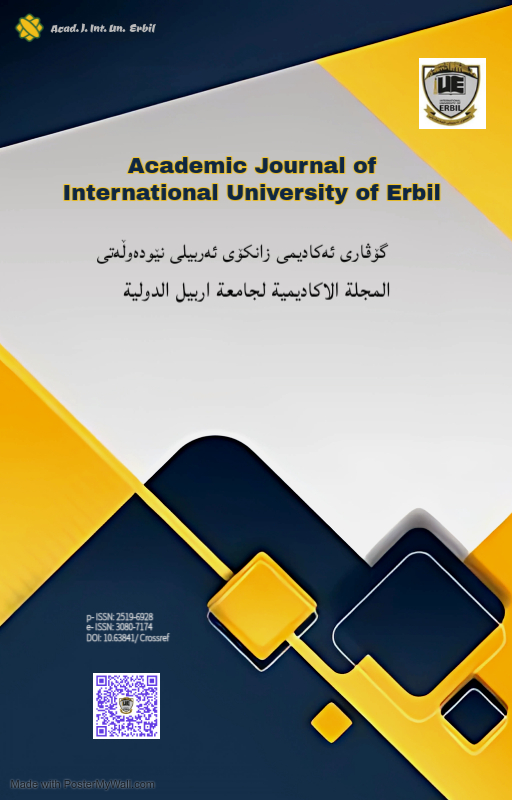Analysis of Foreign Exchange Mechanisms and Policies in Iraq: Focus on Central Bank Transactions and Market Dynamics for the Period (2004-2023)
Analysis of Foreign Exchange Mechanisms and Policies in Iraq
DOI:
https://doi.org/10.63841/23521Keywords:
Foreign Exchange Mechanisms, Central Bank Policies, Financial Market Dynamics, Foreign Exchange Windows, Central Bank of Iraq Operations, Monetary Policy and Exchange Rate.Abstract
This study examines the impact of foreign exchange policies on Iraq's economy and financial markets, with a focus on the role of the Central Bank of Iraq (CBI) in stabilizing the foreign exchange market. The research investigates mechanisms such as the CBI's purchases of foreign currencies from the Ministry of Finance, foreign exchange windows (both remittance and cash-based), and transfers related to documentary credits, and their effects on liquidity, exchange rate stability, and total monetary credit.
Statistical analysis showed that all variables are normally distributed (p-values > 0.05) and that exchange operations were stable. Cointegration tests revealed a long-term equilibrium relationship between the policies and financial stability, affirming the effectiveness of CBI interventions.
Regarding the impact of these mechanisms, the CBI's purchases from the Ministry of Finance showed a small positive but statistically insignificant effect on total monetary credit (coefficient = 4.32E-06, p = 0.23670). Foreign exchange sales through remittances showed a small negative but statistically insignificant effect on total monetary credit (coefficient = -2.12E-06, p = 0.71480). Cash-based foreign exchange sales showed a small positive but statistically insignificant effect (coefficient = 4.01E-05, p = 0.48520). However, transfers related to documentary credits showed a statistically significant positive effect on total monetary credit (coefficient = 0.000345, p = 0.00740), confirming that these transfers are the key factor in improving liquidity and market stability.
Hypothesis testing results indicated that the CBI's interventions in the foreign exchange market have a significant impact on market stability, particularly through transfers related to documentary credits. The model explains a large proportion of the variance in total monetary credit, while the Durbin-Watson statistic (1.215312) suggests no major autocorrelation in the data. The findings underscore the importance of a strong legal and institutional framework to enhance market confidence, regulatory efficiency, and financial resilience. Strengthening Iraq's foreign exchange policies is critical for reducing market volatility, attracting investment, and ensuring sustainable growth. The study provides recommendations for improving monetary policies to achieve long-term economic stability and development.
References
C. J. Anwar, N. Okot, I. Suhendra, & S. Yolanda “Response of exchange rates to monetary policy shocks: nn evidence from Indonesia,” International Journal of Economics and Financial Studies, vol.14, no.1, pp.443-446, 2022.
M. Ferrari et al., “Monetary policy and exchange rate sensitivity in an era of ultra-low interest rates,” 2017.
A. K. Hamad, “Foreign exchange market pressure index and monetary policy in Iraq,” ECONOMIC ANNALS, Volume LXIII, No. 219, 2018.
S. H. Hasan et al., “An econometric study of the impact of monetary policy on foreign direct investment in Iraq for the period (2004-2017),” International Journal of Economics and Business Administration, Volume VIII, no. 3, pp.579-588, 2020.
S. S. I. Jubouri, & A. F. M. Al-Azzawi “Measuring and analyzing the impact of the dollar exchange rates on foreign trade in Iraq for the period (2005-2015),” Tikrit Journal of Administration & Economic Sciences, vol.3 ,no.39, pp.1-18, 2017. In Arabic.
H. A. Kadhem, “The impact of outward bank transfers on exchange rates in Iraq,” Tikrit J. Admin. Econ. Sci., Vol. 19, No. 63, Part (2), pp.593-612, 2023.
L. B. Khudhair, “Effect of global oil price volatility and exchange rate policy on foreign exchange reserves in Iraq,” International Journal Proffesional Business Review, vol.7, no.8, pp.1-28, 2023.
W. Li, M. C. S. Wong, & J. Cenev, “High-frequency analysis of macro news releases on the foreign exchange market: A survey of the literature,” Big Data Research, vol.2, no.1, pp.33-48, 2015.
L. Lin et al., “The fish-eye visualization of foreign currency exchange data,” In Proc. Asia Pacific Symposium on Information Visualization (APVIS2005), Sydney, Australia. CRPIT, 45. Hong, S.-H., Ed. ACS. 91-96, 2005.
J. M. Hussein, & K, I. Saleh, “Impacts of US dollar exchange rates on some financial and economic indicators in Iraq - An analytical study for the period 2009-2015,” Tikrit Journal for Management and Economics, vol4, no.40, pp.10-26, 2017. In Arabic.
C. J. Neely, & S. R. Dey, “A survey of announcement effects on foreign exchange returns,” Federal Reserve Bank of St. Louis Review, vol.92, no.5, pp. 417-463, 2010.
C. J. Neely, “A survey of announcement effects on foreign exchange volatility and jumps,” Federal Reserve Bank of St. Louis Review, vol.93, no.5, pp. 361-407, 2011.
A. A. Odeh, N. S. Jearah, F. H. Mosachet, and M. M. Ibrahim, "The causal relationship between the foreign exchange window and financial stability in Iraq for the period (2004-2018)," Multicultural Education, vol.6, no.1, pp.186-201, 2020.
H. Z. Oleiwi, "Selling the currency window in the Central Bank of Iraq and exchange rate risks: An analytical study for the period from 2016 to 2019," International Journal of Research in Social Sciences and Humanities, vol.13, no.3, pp.299-306, 2023.
R. Rahmat, S. Nur, A. Patahuddin, & A. Adil, "Jual beli mata uang sistem trading forex dalam perspektif hukum Islam," AL-KHIYAR: Journal Bidang Muamalah dan Ekonomi Islam, vol.1, no.1, pp.60-70.2021. In Indonesian.
S. Sarmedi, "Jual beli valuta asing dalam perspektif hukum Islam," El-Ecosy Jurnal Ekonomi dan Keuangan Islam, vol.1, no.2, pp.211-236, 2021. In Indonesian
R. R. Rebitzky, "The influence of fundamentals on exchange rates: Findings from analyses of news effects," Journal of Economic Surveys, vol.24, no.4, pp.680-704,2010.
A. Rose, "Testing for ‘news’ in foreign exchange markets," Economics Letters, vol.14, no. 4, pp. 369-376, 1984.
M. S. Sangeetha et al., "An overview of retail foreign exchange investors' behavior," International Advanced Research Journal in Science, Engineering and Technology, vol.9, no.4, pp.552-557, 2022.
H. N. Semiromi et al., "News will tell: Forecasting foreign exchange rates based on news story events in the economy calendar," 2020.
A. S. Mahood, A. S. Muneer, “The role of the foreign currency selling window in) The inflation rate in Iraq for the period (2004-2020),” World Economics and Finance Bulletin, vol.18, pp.105-111, 2023.
H. M. Al-Shammari and S. J. Al-Quraishi, “Evaluation of the foreign currency auction as a tool for monetary policy in Iraq for the period (2003-2017),” Iraqi J. Admin. Sci., vol. 16, no. 56, 2021.
M. Y. Khudair and W. A. Hassan, “The role of the currency selling window in the stability of the Iraqi dinar exchange rate and its implications for inflation,” Journal of Accounting and Financial Studies., vol. 17, no. 60, pp.90-104, 2022. In Arabic.
C. A. Cuevas and A. M. Werner, “The Mexican Experience with a Floating Exchange-Rate Regime,” IMF Working Paper, International Monetary Fund, 2001.
R. P. Méndez, “Harnessing the global foreign currency market: Proposal for a foreign currency exchange (FXE),” Rev. Int. Polit. Econ., vol. 3, pp. 498-512, 1996. Available: https://api.semanticscholar.org/CorpusID:153894743
C. S. McCarty, “Currency auctions: Minimizing collusive behavior,” J. East-West Bus., vol. 8, no. 1, pp. 31-50, 2002.
M. Lang and I. Krznar, “Transmission mechanism of monetary policy in Croatia,” Croatian National Bank, 2004.
B. M. H. Qasim, "Measuring the impact of the foreign exchange sales window on exchange rate fluctuations and money supply in the foreign exchange market," M.S. thesis, Univ. of Baghdad, 2017.
L. Tair, “Banking techniques,” 6th ed. Algiers: Diwan University Press, 2007.
M. M. Saleh, “Monetary policy in Iraq: Building economic stability on a sound financial system,” 1st ed. Baghdad, 2012.
H. N. Bakhit and N. H. Maznan, “The impact of the tight money supply on the exchange rate of the Iraqi Dinar during the period 1980-1995,” J. Kufa Stud. Center, vol. 1, no. 5, 2006.
Z. M. H. Al-Yassin and A. G. Mahdi, “Legal provisions for bank auditing: A comparative study,” Al-Mohaqiq Al-Hali Journal of Legal Political Science., vol. 8, no. 4, 2016.
A. T. D. Al-Ahbabi, “Analyzing and measuring the role of the Central Bank of Iraq in controlling inflation using the window for selling foreign currency, legal reserves, and money supply for the period (2003-2017),” M.S. thesis, College of Administration and Economics, University of Tikrit, 2019.
E. Kowalewska, “The role of the central bank in foreign exchange inspection in selected countries of the European Union – As seen in the example of Poland, the Czech Republic, and Germany,” Rev. Eur. Comp. Law, 2021. Available: https://api.semanticscholar.org/CorpusID:243168215
M. S. Mohanty and B. Berger, “Central bank views on foreign exchange intervention,” PSN: Exchange Rates & Currency (International), 2013. Available: https://api.semanticscholar.org/CorpusID:166820318
K. Basu and A. Varoudakis, “How to move the exchange rate if you must: The diverse practice of foreign exchange intervention by central banks and a proposal for doing it better,” World Bank Policy Research Working Paper No. 6460, 2013. Available: https://ssrn.com/abstract=2269533
R. F. Engle and C. W. J. Granger, “Co-integration and error correction: Representation, estimation, and testing,” Econometrica, vol. 55, no. 2, pp. 251-276, 1987. Available: https://econpapers.repec.org/article
A. Göksu and U. Ergün, “Applied Econometrics with Eviews Applications.,” International Burch University, 2013. Available:https://www.researchgate.net/publication/269113492_APPLIED_ECONOMETRICS_With_Eviews_Applications.
G. Bresson and A. Pirotte, Economie des séries temporelles, 1st ed. Paris: Belin, 1995. Available: https://belinra.inrae.fr/index.php?lvl=notice_display&id=55355
M. A. A. Abdel Qader, “Modern Econometrics Between Theory and Practice,” University Publishing House, 2004.
Downloads
Published
Issue
Section
License
Copyright (c) 2025 Academic Journal of International University of Erbil

This work is licensed under a Creative Commons Attribution-NonCommercial-NoDerivatives 4.0 International License.












